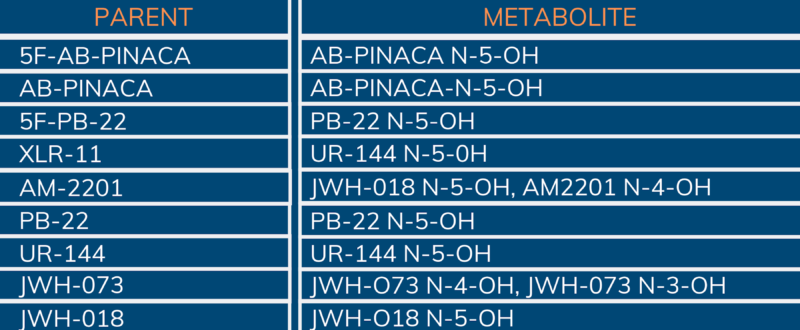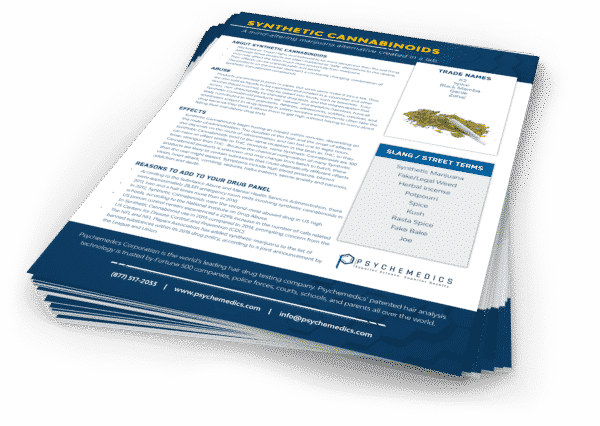SYNTHETIC CANNABINOIDS
Not legal. Not safe. But still here.
What are synthetic cannabinoids?
Descriptions
Synthetic Cannabinoids refer to man-made mind-altering chemicals that are either sprayed on dried, shredded plant material so they can be smoked (herbal incense) or sold as liquids to be vaporized and inhaled in e-cigarettes and other devices (liquid incense).
Synthetic cannabinoids are actually more effective at binding to receptor sites in the brain than marijuana is, thus making them more potent and potentially more dangerous than plant-based marijuana.
Synthetic Cannabinoids are often marketed as a “legal high” alternative to marijuana, and are commonly sold as incense in retail stores, head shops and on the internet. In response to reports of an alarming increase in abuse and overdoses, the Federal Government has classified many synthetic substances as Schedule I drugs under the U.S. Controlled Substances Act — the same category as heroin and LSD.
Analytes
5F-AB PINACA, AB-FUBINACA, AB-PINACA, ADBICA, ADB-PINACA, AB-CHMINACA, 5F-PB-22, XLR-11, AM-2201, PB-22, UR-144, JWH-073, JWH-018, BB-22, and APINACA
Street Names / Slang Terms
Spice, Yucatan Fire, Blaze, Zohai, Black Mamba, Bliss, Genie, Blonde, Red X Blend, Sky High, Skunk, Moon Rocks, Galaxy Gold, Scooby Snax, Black Voodoo, Green Giant, Smacked, Wicked X, Ninja, Mojo, Bizzaro, AK-47, Citron, Nice Guy
Contact Psychemedics Today
What Do Amphetamines Look Like?
Synthetic cannabinoids are human-made mind-altering chemicals that are either sprayed on dried, shredded plant material so they can be smoked or sold as liquids to be vaporized and inhaled in e-cigarettes and other devices.
When sprayed on crushed plant material they are sold in baggies or wrapped in foil and resemble marijuana, herbs or other plant matter. When sold as oils they can be packaged any number of ways.
How Are They Used?
For coated plant material the drug is rolled into cigarettes or smoked in pipes.
The oil form of the drug is either put on plant materials to be smoked or is smoked in its oil form in a vaping device.
Some users make the drug into a tea or have been known to mix it into an edible.
Fast Facts About Synthetic Cannabinoids
Why choose Psychemedics to Test for Synthetic Cannabinoids?
Unrivaled Detection plus Unmatched Deterrence for starters.
Psychemedics was the first laboratory in the world to develop and market a workplace and campus hair test for synthetic cannabinoids.
The screen for the Psychemedics test is continually updated to address changes in the synthetic cannabinoids market, adding additional parent compounds to the screen as they are identified and reported by the scientific, law enforcement and regulatory communities. As with all Psychemedics tests a 90-day window of detection enables identification of chronic or habitual users, a key advantage over other methods.
Large and small companies, private, public and faith-based schools and some of the country’s largest law enforcement agencies rely on Psychemedics. Why?
Unrivaled Detection. Unmatched Deterrence. Unequaled Legal Record.
Our non-invasive testing procedure uses a sample of hair that is up to 60% less than that required by any hair testing lab which is easily collected and shipped to our College of American Pathologists (CAP) and ISO-IEC 17025:2005 certified laboratory. Turnaround on most results is the best in the industry.
Psychemedics has detected more drug users for more companies than any hair testing lab in the world and our results have been accepted by courts across the country. Contributing to our unmatched legal track record, it is the only hair test with safeguards validated by the FBI to protect those tested from false positive results by differentiating between ingestion versus external exposure to a drug. Our clients confidently make policy decisions knowing that we go the extra mile to ensure fairness to those tested.
View the press release announcement to learn more about this test.
What We Detect

Keep Current On Drugs Of Abuse
We have put together an information sheet on Synthetic Cannabinoids to help you understand the threats and recognize the symptoms of abuse. You can download the document for your reference or to share with others who may benefit from the information we have shared.

More Information About Synthetic Cannabinoids
Short Term Effects
Synthetic cannabinoids are designed to mimic the psychoactive ingredient in marijuana, THC, although they are generally much more potent. This is due in part to the fact that they are synthesized to work better at binding to the cannabinoid receptors in the brain. These receptors, responsible for pleasure centers and mood are the same as for marijuana and can trigger adverse side effects including vivid hallucinations, delusions, paranoia, or other psychotic symptoms under the influence of this much more powerful psychoactive drug.
Short term side effects associated with synthetic cannabinoids might include feelings of lightheadedness, dizziness, confusion and tiredness, excitement, agitation, and aggression or mood swings to suicidal thoughts. Additionally the drug can effect memory to include amnesia, and bring on physiological symptoms such as hot flashes.
Long Term Effects
As with most drugs, people who abuse synthetic cannabinoids for a long period of time may develop a dependence on the drug. Withdrawal symptoms are an expected outcome. National Institute on Drug Abuse (NIDA) cites several symptoms of withdrawal that may present themselves on cessation of use. Physical symptoms and discomfort may include muscle aches, insomnia, fatigue, sweating, chills, headache, stomach cramps, fever, and changes in appetite.
Though unpleasant, and depending on the individual and level of dependency, the withdrawal symptoms are usually short lived. Psychological symptoms of withdrawal as with many drugs that effect the pleasure centers of the brain include depression, trouble concentrating or lapses in memory, difficulty feeling motivated, and anxiety or restlessness.
Can you spot the drug user in this group?
Psychemedics can.
We do it every day.
The Psychemedics Advantage
Your objective is a drug-free workplace.
Your challenge is to detect and deter drug usage.
Unrivaled Detection. Unmatched Deterrence.
That is the Psychemedics Advantage.
Drug News You Can Use
Sign up for our quarterly newsletter to stay up-to-date with snapshots of usage statistics, information on the latest trends, and updates on detection science.



